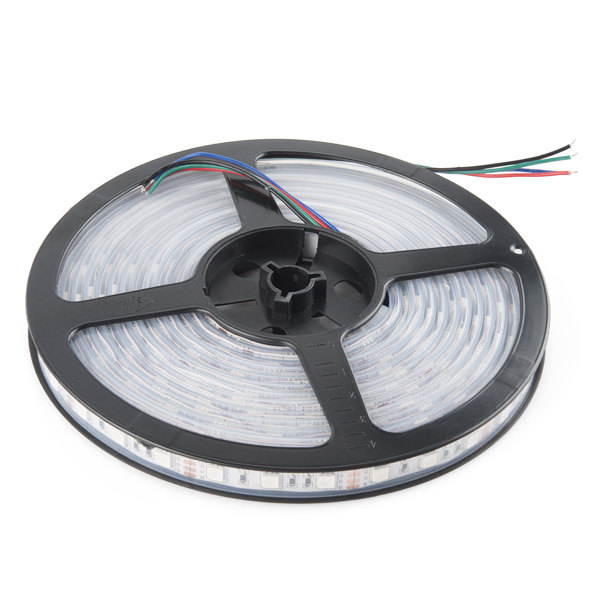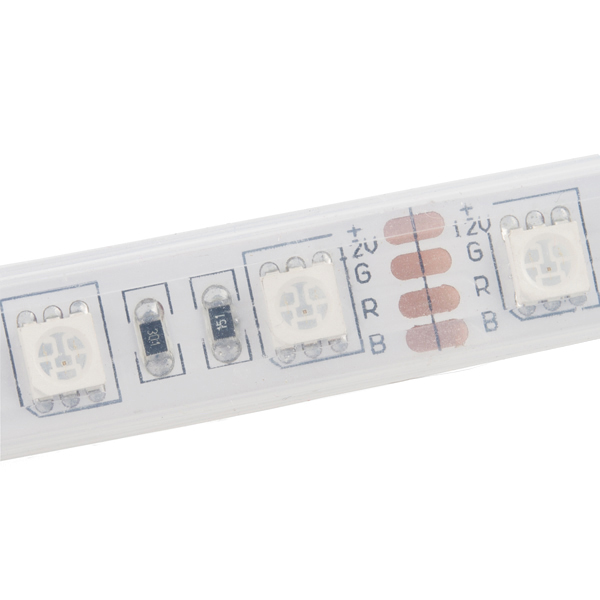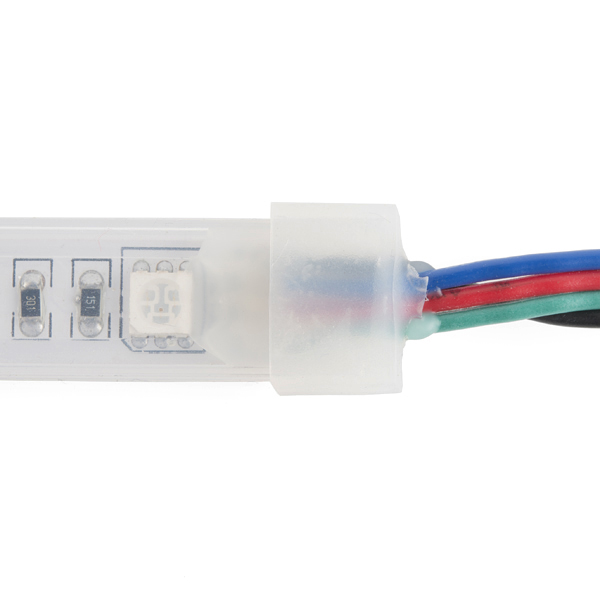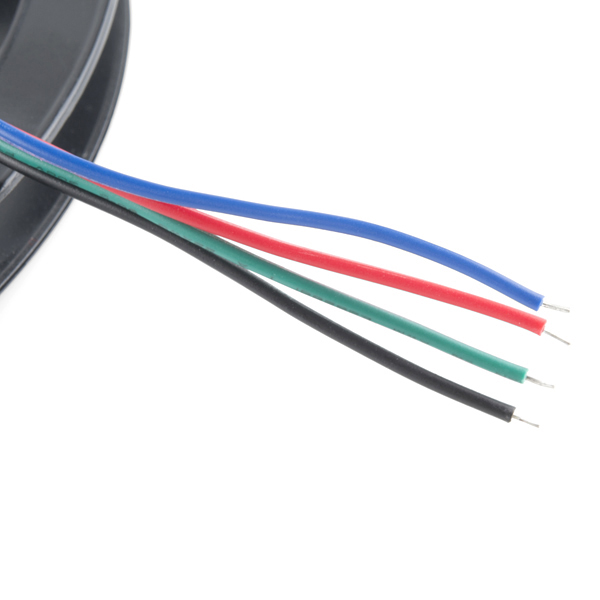LED RGB Strip - Sealed (5m)
Gone are the days that you have to worry about silicone water proofing splitting and breaking on you! These are sealed non-addressable 5 meter long RGB LED strips that come packed with 60 5060 LEDs per meter. Each of these strips need a 12V supply and are enclosed by a flexible silicon jacket with an IP65 waterproof rating to protect your precious 5060 LEDs. You will be able to control the whole LED RGB Strip together giving you cool lighting effects for your car, fish tank, or perhaps under cabinet lighting in your kitchen!
Note: These come in 5m segments on a reel. They are preterminated with wires, as shown in the pictures.
- Datasheet (5060 LED)
- Hookup Guide
LED RGB Strip - Sealed (5m) Product Help and Resources
Prototype Wearable LED Dance Harness
February 8, 2018
A project tutorial to add an extra effect for dancers performing a choreographed piece. The harness can be added quickly under a costume.
Interactive 3D Printed LED Diamond Prop
April 19, 2018
In this tutorial, we will learn about how to create an interactive theatrical prop for a performance by 3D printing a translucent diamond prop using a non-addressable RGB LED strip and AT42QT1011 capacitive touch sensing.
Light Up Your 3D Printer's Bed
June 27, 2018
Having issues viewing your print in a dark lit room? In this tutorial, we will be using LED strips to light up a print bed's area on a LulzBot 3D printer!
Motion Controlled Wearable LED Dance Harness
January 30, 2019
Control LEDs based on your movement using an accelerometer! Make your LEDs breathe by fading in and out when laying on the floor, turn off the LEDs when moving to your side, or make the LEDs blink in a headstand!
Non-Addressable RGB LED Strip Hookup Guide
February 19, 2020
Add color to your projects with non-addressable LED strips! These are perfect if you want to control and power the entire strip with one color for your props, car, fish tank, room, wall, or perhaps under cabinet lighting in your home.
Fritzing Part
The closest Fritzing part related to this LED strip can be found here:
If you are looking at the details, the LED is flipped and IC is the 5060 package.
Powering
Apply +12V to the + pin and ground any of the colored wires to turn the LED color on. When using with a microcontroller, you would need an n-channel mosfet https://www.sparkfun.com/products/10213 to turn it on and off. The LED strips require a lot of power (especially the 5M strips) but worked well with a variable power supply set at 12V/1A. The LED strip does get warm to the touch when using.
Core Skill: Programming
If a board needs code or communicates somehow, you're going to need to know how to program or interface with it. The programming skill is all about communication and code.
Skill Level: Rookie - You will need a better fundamental understand of what code is, and how it works. You will be using beginner-level software and development tools like Arduino. You will be dealing directly with code, but numerous examples and libraries are available. Sensors or shields will communicate with serial or TTL.
See all skill levels
Core Skill: Electrical Prototyping
If it requires power, you need to know how much, what all the pins do, and how to hook it up. You may need to reference datasheets, schematics, and know the ins and outs of electronics.
Skill Level: Competent - You will be required to reference a datasheet or schematic to know how to use a component. Your knowledge of a datasheet will only require basic features like power requirements, pinouts, or communications type. Also, you may need a power supply that?s greater than 12V or more than 1A worth of current.
See all skill levels
Comments
Looking for answers to technical questions?
We welcome your comments and suggestions below. However, if you are looking for solutions to technical questions please see our Technical Assistance page.
Customer Reviews
4 out of 5
Based on 1 ratings:
LED RGB Strip sealed
it has decent ambiance, but the light doesn't penetrate anywhere even with maximum rated power applied.





Since Sparkfun has provided very little information about this light strip, I did some investigating of my own. I believe the circuit is identical to this one shown on Adafruit except that it has a 150-ohm resistor instead of a 130-ohm one for the blue and green LEDs: http://learn.adafruit.com/rgb-led-strips/schematic
On paper, giving the strip 12V and grounding the other three pins should result in a current of 20mA through each red LED and 18mA through each blue and green LED, totaling 56mA per group of 3 RGB LEDs. Since there are 20 groups of 3 RGB LEDs per meter, the current should be 1.12A per meter and 5.6A per 5-meter strip.
I tested a small strip to see if my numbers were close. I put 12V on a strip that was 6 groups long, and it drew 300mA, which comes out to 50mA per group (11% less than expected).
Summary:
expected current @12V = 56 mA/group, 1.12 A/m, 5.6 A/strip
measured current @12V = 50 mA/group, 1.00 A/m, 5.0 A/strip
You just need to apply +12V to the + pin and ground any of the colored wires to turn the LED color on. If you want use it with a microcontroller, you would need an n-channel mosfet https://www.sparkfun.com/products/10213 to turn it on and off. The LED strips require a lot of power (especially the 5M strips) but it worked good with my variable power supply set s 12V/1A. The LED strip does get warm to the touch when using.
Does this strips come with 3M adhesive tape? Do you have any ideas of how to stick this strips to a surface?
Thanks!
Yes, it comes with 3m adhesive tape.
I bought 2 of these in 5m length. I tested them with a large lead acid battery producing 12.65V. I found the following
When individually connected the draw was the following Red: 1.6 Amps Green: 1.4 Amps Blue: 1.34 Amps
When all were connected White: 3.4 Amps. (Voltage on battery dropped to 12.4V when lit.
Not sure why there is a discrepancy, this is empirical data.
Hope this helps
What would be a good power supply to use with these? I assume that the requirements for current will be significant, and not just any power supply will make the cut.
I'm powering similar strips using old VGA monitor power supplies (12V, 8A),with some extra power lines to points at the middle and end of the strip to deal with the losses along the length of the strip.
Note that this only applies to these 'dumb' LED strips. The addressable ones tend to require slightly more beefy power supplies while running off of 5V - a computer PSU might be a good match there.